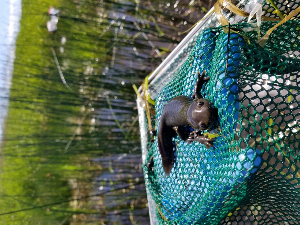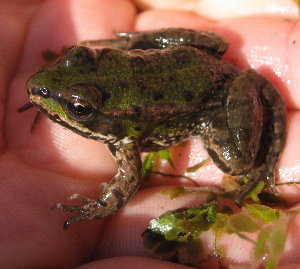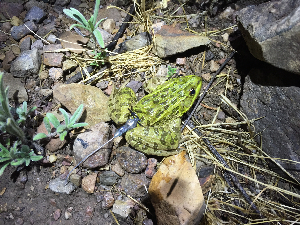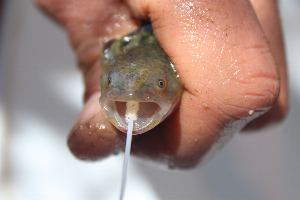Search ARMI Database
Search term(s)
Contribution Number
Search Results
146 record(s) found.
Papers & Reports Associations between environmental pollutants and larval amphibians in wetlands contaminated by energy-related brines are potentially mediated by feeding traits
Papers & Reports Heterogeneous responses of temperate-zone amphibian populations to climate change complicates conservation planning
Papers & Reports Post-breeding movement and habitat use by Wood Frogs along an Arctic-Subarctic ecotone
Papers & Reports Increasing connectivity between metapopulation ecology and landscape ecology
influences ecological processes, yet these disciplines address the problem using fundamentally different modeling approaches. Metapopulation models describe how the spatial distribution of patches affects colonization and extinction, but often do not account for the heterogeneity in the landscape between patches. Models in landscape ecology use detailed descriptions of landscape structure, but often without considering colonization and extinction dynamics. We present a novel spatially explicit modeling framework for narrowing the divide between these disciplines to advance understanding of the effects of landscape structure on metapopulation dynamics. Unlike previous efforts, this framework allows for statistical inference on landscape resistance to colonization using empirical data. We demonstrate the approach using 11 yr of data on a threatened amphibian in a desert ecosystem. Occupancy data for Lithobates chiricahuensis (Chiricahua leopard frog) were collected on the Buenos Aires National Wildlife Refuge (BANWR), Arizona, USA from 2007 to 2017 following a reintroduction in 2003. Results indicated that colonization dynamics were influenced by both patch characteristics and landscape structure. Landscape resistance increased with increasing elevation and distance to the nearest streambed. Colonization rate was also influenced by patch quality, with semi-permanent and permanent ponds contributing substantially more to the colonization of neighboring ponds relative to intermittent ponds. Ponds that only hold water intermittently also had the highest extinction rate. Our modeling framework can be widely applied to understand metapopulation dynamics in complex landscapes, particularly in systems in which the environment between habitat patches influences the colonization process.
Papers & Reports Status of the Threatened Chiricahua Leopard Frog and Conservation Challenges in Sonora, Mexico, with Notes on Other Ranid Frogs and Non-native Predators
News & Stories Interpretive sign highlighting the federally threatened Chiricahua Leopard Frog debuts at Buenos Aires National Wildlife Refuge
An interpretive sign was installed on August 1st, 2017 near the headquarters and visitor information office at Buenos Aires National Wildlife Refuge (BANWR, Sasabe, Arizona). The sign provides information on the federally-threatened Chiricahua Leopard Frog (Lithobates chiricahuensis) and is located next to an example of typical habitat (a cienaga). In addition to the biology and behavior of this desert frog, the sign gives a friendly reminder to brake for amphibians on Refuge roads, especially during the summer monsoon season when amphibians are more likely to be moving between habitats; in the desert, as for many animals, the cienagas and cattle tanks retain water and are key refuges during drought.
This interpretive sign, the first highlighting an amphibian on BANWR, was originally designed to educate visitors about the Chiricahua Leopard Frog, but the sign has become a template and an inspiration for further educational efforts. Additional signs are in the works at BANWR to provide interpretive information along a planned nature walk near Refuge headquarters and at the flight pen for the federally endangered Masked Bobwhite Quail. Based on the design of the Chiricahua Leopard Frog sign, interpretive information is being created to highlight all of the diverse flora and fauna at BANWR and give the visitor a better idea of the complex and interconnected lives of the organisms they might encounter as they enjoy the scenery and arid landscape of the Refuge.
The Chiricahua Leopard Frog interpretive sign was a concept initiated during a stakeholder meeting in February 2017, at BANWR, where decision science methods were applied to discuss refuge priorities (e.g., Chiricahua Leopard Frog conservation, general refuge management). Stakeholders included personnel from U.S. Fish and Wildlife Service, Arizona Game and Fish Department, U.S. Geological Survey, and the University of Georgia. The sign was designed through collaborative effort among those entities and funded via Jones-Lovich grant in Southwestern Herpetology from the Herpetologists' League. Work on declining amphibians at BANWR and the Borderlands was initiated by Cecil Schwalbe (USGS, ARMI-retired) and has been continued by Brent Sigafus, Blake Hossack and Erin Muths (Rocky Mountain and Southwest ARMI).
Papers & Reports Widespread Legacy Brine Contamination from Oil Production Reduces Survival of Chorus Frog Larvae
Papers & Reports Evaluation of wetland mitigation in the Geater Yellowstone Ecosystem: Wildlife population and community responses
Papers & Reports Declines revisited: long-term recovery and spatial population dynamics of tailed frog larvae after wildfire
Papers & Reports Informing recovery in a human-transformed landscape: drought-mediated coexistence alters population trends of an imperiled salamander and invasive predators
Papers & Reports Additive impacts of experimental climate change increase risk to an ectotherm at the Arctic’s edge
Papers & Reports Even with forewarning, challenges remain in developing a proactive response to emerging infectious diseases
Papers & Reports Amphibian dynamics in constructed ponds on a wildlife refuge: developing expected responses to hydrological restoration
Papers & Reports Influence of climate drivers on colonization and extinction
temperature, precipitation, and evapotranspiration (i.e., climate drivers) are likely to alter flooding regimes of wetlands and affect the vital rates, abundance, and distributions of wetland-dependent species. Amphibians may be among the most climate-sensitive wetland-dependent groups as many species rely on shallow or intermittently flooded wetland habitats for breeding. Here, we integrated multiple years of high-resolution gridded climate and amphibian monitoring data from Grand Teton and Yellowstone National Parks to explicitly model how variations in climate drivers and habitat conditions affect the occurrence and breeding dynamics (i.e., annual extinction and colonization rates) of amphibians. Our results showed that models incorporating climate drivers outperformed models of amphibian breeding dynamics that were exclusively habitat based. Moreover, climate-driven variation in extinction rates, but not colonization rates, disproportionately influenced amphibian occupancy in monitored wetlands. Long-term monitoring from national parks coupled with high-resolution climate data sets will be crucial to describing population dynamics and characterizing the sensitivity of amphibians and other wetland-dependent species to climate change. Further, long-term monitoring of wetlands in national parks will help reduce uncertainty
surrounding wetland resources and strengthen opportunities to make informed, science-based
decisions that have far-reaching benefits.
News & Stories ARMI scientists Blake Hossack (NOROCK), Brent Sigafus (SBSC) and Erin Muths (FORT), and ARMI post doc Thierry Chambert traveled to Sonora, Mexico, to survey for Sonoran Tiger Salamanders in May 2016
ARMI scientists Blake Hossack (NOROCK), Brent Sigafus (SBSC) and Erin Muths (FORT), and ARMI post doc Thierry Chambert traveled to Sonora, Mexico, to survey for Sonoran Tiger Salamanders in May. Reports existed of the presence of this salamander in Sonora, but the spatial extent of its range is unknown. The Sonoran Tiger Salamander is federally endangered in the US and is found only in the San Rafael Valley in southern Arizona. The identification of additional populations in nearby Sonora has implications for multiple conservation concerns including population biology, genetics, and disease. Data collected about its presence and abundance across the border will contribute to the identification of management objectives and subsequent implementation of conservation actions. The surveys were a collaborative effort with logistical support from Naturalia (http://www.naturalia.org.mx/) that included the expertise of Naturalia employees Daniel Toyos and Ramon Babuca. The trip also benefitted from assistance from Guillermo Molina (Instituto Tecnológico Superior De Cananea), Julio Lemos Espinal (UNAM), and students David Hurtado and Aline Estrella. Jim Rorabaugh contributed much to the trip by sharing knowledge of the Sonoran system gained from his previous expeditions focused on salamanders in Mexico. The effort was based at Rancho Los Fresnos, a Naturalia property located north of the town of Cananea and adjacent to the US–Mexico border. The group sampled a variety of sites on Rancho Los Fresnos, as well as surrounding ranches and locations to the south of Cananea. Tiger salamanders reside primarily in man-made or modified earthen stock tanks. These habitats were seined for salamanders and water samples were collected to test for environmental DNA (eDNA) from salamanders, invasive American bullfrogs, federally-threatened (USA) Chiricahua leopard frogs, and pathogens that cause amphibian diseases. Buccal swabs were collected from captured salamanders for genetic analyses (there is uncertainty in determining the difference among closely related salamanders in the field); and skin swabs were collected to test for disease (both Batrachochytrium salamandrivorans and B. dendrobatidis). This ongoing project has already produced one publication (Hossack et al. 2016. Notes on the Distribution of Tiger Salamanders (Presumed Ambystoma mavortium stebbinsi) in Sonora, Mexico. Herpetological Review 47(2): 177-180), and another is in preparation (Hossack et al. Informing recovery of an imperiled, endemic salamander: coupled dynamics and test of drought-mediated coexistence with invasive predators).





